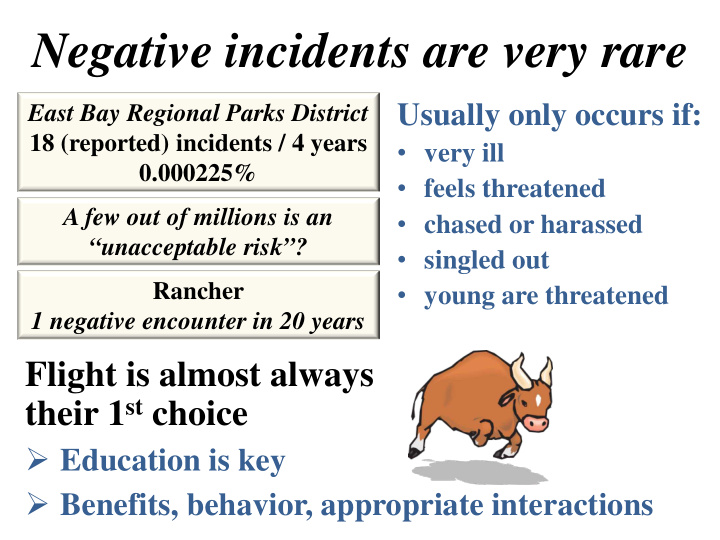



Negative incidents are very rare Usually only occurs if: East Bay Regional Parks District 18 (reported) incidents / 4 years • very ill 0.000225% • feels threatened A few out of millions is an • chased or harassed “unacceptable risk”? • singled out Rancher • young are threatened 1 negative encounter in 20 years Flight is almost always their 1 st choice Education is key Benefits, behavior, appropriate interactions
Compatibility of livestock & recreation Rancher “You have to do everything you can to reduce liability and conflict. If you don’t understand that, you shouldn’t be on public ground. You are there as a PRIVILEGE … Anything and everything you do has to reduce or eliminate conflict, and this is what it is about on public ground…” Consultant “Grazing is not only compatible [with recreation], it is MANDATORY [for grassland management].” Rancher “[Cattle grazing on public lands] may not be easy, but the whole key is that the cattle owner and the land agency need to work together… very little COMMUNICATION is often the problem.”
What types of recreational activities occur on grazed lands? Percentage of land managers observing recreational activities on grazed lands in the Central Coast of California, based on phone, in-person, and email interviews. Activity Percent Activity Percent Cultural/Heritage/Archaeological Sites 54 Dog Walking** 46* Cattle Drive 69 Biking** 62* Ranch Retreat 38 Falconry 23 Horse Camp 38 Fishing 38 Hunting 62 Picnics 31 Bed & Breakfast 31 Kites 31 ATV** 54 Hang Gliding 8 Camping 46 Birding 100* Hiking** 100 Other Wildlife Viewing 77* Horseback Riding** 85 Other Activities 54 * Most common problematic interactions with livestock ** Most common ≠ most problematic all the time And outcomes are generally positive!
Barriers to public lands’ grazing Rancher “Overwhelmingly it has been a positive relationship between me, the cattle, and the enjoyment of the visiting public. But it takes only a couple of negative encounters to leave a lasting IMPRESSION with me.” Lands Manager (park agency) “I had about a miles worth of fence cut due to PEOPLE angry with cattle grazing… and for 2 years [the park] quit grazing and hired someone to be part of a management plan process and create a grazing plan. [After grazing was resumed], it took 6-7 years to knock back the thatch and bring back flowers, and many wildflower have not recovered since. The grazing removal had obvious and clear ramifications.” Rancher “Often I feel that the agency people THINK I am just throwing my cattle out on the land, and am getting paid to do nothing. That is not the case; as a rancher you work hard to create your own profit. ”
What do managers do to help? • Perform other ecological services – Plant trees – Pick up trash – Fix fences – Maintain water for dogs, horses, and wildlife – Keep gates in easy working order • Choose the best stock for public lands – Select animals with proven dispositions – Sound stockmanship – Remove aggressive, sick, or injured animals • Reduce interactions during potentially higher risk periods – Bulls far away during breeding – Livestock away from high recreation areas when calving – Plan around peak recreational periods 5
What can visitors do? • Read all signs • Check online for updates – Webpage – Facebook – Twitter • Leave gates as you find them • Report maintenance needs promptly • Ask questions
Learn how livestock behave • Walk towards you – Curiosity ≠ Aggression • Paw or root through your belongings • May become frightened or feel threatened – unfamiliar objects – fast-moving vehicles or bikes – off-leash dogs – running or yelling – dogs/people near their young
Cows and Calves • Most injuries occur during calving season • Do not walk directly at livestock • Give a wide berth • Avoid startling • Livestock want to protect their young • Do not get between mamas and their calves
If you see a calf alone… • Do not get close • If bawling loudly or clearly in severe distress call 911 • Note waypoints, eartag number if possible, and description 9
If you encounter animals in a large group… • Go around them, NOT through them • Give them space Graziers’ responsibilities • Inform and educate • Walk at normal pace • Keep calm & regather • Use calm voice • If you have an animal – Secure dog leash – Dismount horse, maintain control
Dog Walking • Dogs must remain on-leash always to: – protect wildlife – keep children and other visitors safe – prevent dog fights – protect from injury – prevent chasing other animals • Only dogs owned by rancher may herd livestock • Do not allow dogs to chase or bark at other animals • Report off-leash dogs and harassment of animals to park staff or grazier
IF you feel threatened • Turn sideways • Move away slowly • Keep calm • Speak in soft voice • Do not run • Report concerns to park staff or rancher • Identify animal as best as possible – Eartag number, description, gender, age, location, waypoints
Recommend
More recommend